Welcome to FISH FOOD TIMES
Oct. 2015 issue No.142

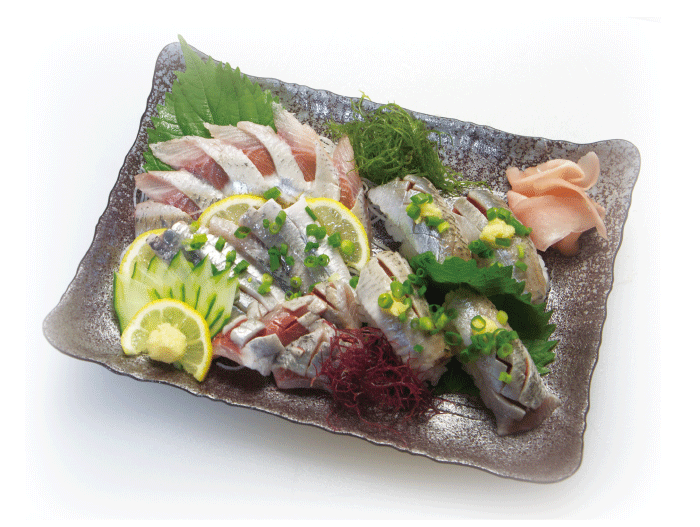
All of sardine (sashimi and nigiri sushi)
October 4 is the day of the sardine.
Sardines of the day, the October 4 so on i (1) wa (0) shi (4), it is of the pun, in 1985, Osaka multi-catch of fish effective utilization review meeting but it is that of the proposed.
Although sardine in 1988 was catch about 4.5 million tons in Japan, then catches drastically reduced, in 2012 and became 13.6 million tons.
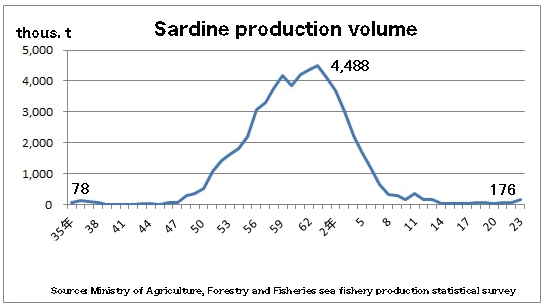
Sardine is the year that were not caught only 09,000 tons in 1965, the catch of 2012 is not that the worst, resource amount of sardine in Japan coast such as by changes in the marine environment, several decades Unit in there is a theory that has been greatly change.
By the fact of the catch drastically reduced, once sardine that was called the "Fish of the illusion" is, in recent years have come to resource recovery is noticeable little by little.
Especially in Hokkaido of the east coast has become a sardine landings increased significantly, for example, landed in Kushiro, that was 3,162 tons in 2012, the 2013 will be 9,483 tons, last year in 2014 to become the 20,523 tons, sharply the landings of quantity extends to. Also record the landings amount that exceeds the previous year over a period from May of July this year, even after becoming September made the boundary between the warm water eddy and the Oyashio Current the coast near the eastern Hokkaido, is good fishing of sardine in this areaIt like is formed.
This period of October ought to saury is the peak of the landing if originally, but away 600�q from Nemuro in the case of this year has become a saury of the main fishing grounds. There is water temperature is low, have become a lean landings are mainly of saury that have not yet fully mature, so far has been conspicuous small saury that lean than usual.
Also in the case of this year, more stringent examination of the Russian border guard stations, because it takes time to check, it is not possible day trip from the fishing grounds that you can day trip if originally. For this reason, the thing of that happening change inevitable problems the fishing port of landing in Kesennuma Port in the Tohoku region rather than the eastern Hokkaido.
This year's saury landings, but there may be a catch until such time landing time is slow shifted in the second half as last year, at the stage of until now in September and is're showing signs of poor catch.
On the other hand, as mentioned above, sardine is not only well is landed in eastern Hokkaido, it as becomes a smooth landing than usual also in Chiba Prefecture Choshi and Tottori Prefecture Sakaiminato.
Sardine is up north from spring to summer, in winter from autumn to perform seasonal migration of down south, and is also referred to as Hirago and Nanatsuboshi an alias. There is a history in Japan has been treated as an important fishery resources from the old days, it but has also become synonymous with edible masses fish, actually often used to feed and fertilizer than edible.
The first place is boiled this After fishing the sardine in the offshore in the old days of Japan, was dried and squeeze the oil "dried residue (dried residue)" has been used as fertilizer for cotton cultivation and rapeseed cultivation. This has a history that became role falling to dramatically increase that the production efficiency of agriculture, become a trigger is that the use of to this agricultural fertilizer, is of like fishing of Japan went to great progress.
As long as the time the sardine as before was 4.5 million tons it is also caught in a year, but seems that there has been what is too much, even with plenty to feed and fertilizer, and so as not to be caught either now annually 100,000 tons mightier in the era, I think by increasing the use toward food, the price of sardine that was higher wants down even a little.
But now, the price of sardine is in the previous also of the price many times is not a simple scheme that's due to the fact that landed amount has decreased, by advances in distribution technology recently, high a sardine freshness level in we were able to transport. Rather than this for sardine in processed marine products, such as low salt interference goods of value, will often be distributed as fresh fish that can be used as "material to be used for sashimi and sushi species" high-value, as a factor that this price has been soaring he such as those enumerated.

The image above example is a size called "big feather sardine" more than the full-length 20 cm that was caught in Hokkaido eastern off the coast at the end of September of this year, was a plump and fat sardine of fat plenty, fine also for more freshness in, more that have not yet missing rigor mortis of remains fish is bent was about half.
The sardine of this freshness outstanding, yet fat plenty, sashimi, sushi, is to make a rice bran boiled cuisine, the skinless fillets in preparation for the first sashimi and sushi was made in the following manner.
The dismantling method, because it does not output almost internal organs abdominal on top of the cutting board, chopping board is not dirt so much, it is a very speedy way.
| "Do not pollute the cutting board" how to make a skinless fillets of sardine for sashimi, sushi. | |
|---|---|
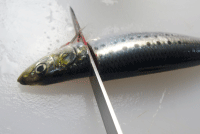 |
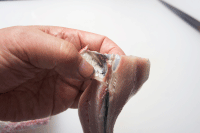 |
| 1, drop the head while which attached chest fin | 7, remove one side of the skin of the body, which opened in finger |
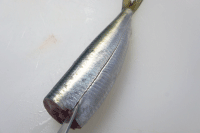 |
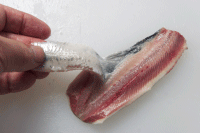 |
| 2, put a shallow kerf in the upper body side | 8, remove carefully the one side of the meat from the skin |
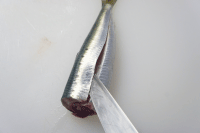 |
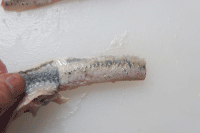 |
| 3, cut deep skin near the kerf | 9, remove the skin and care as opposite of meat also leave the fat |
 |
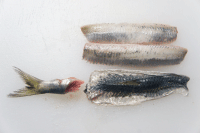 |
| 4, put a a shallow kerf down body side. | 10, divided into body and skin and tail fin |
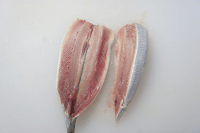 |
 |
| 5, put a deeply knife from the kerf, to separate the meat and internal organs part | 11, sardine 1 fish of skinless fillets that remove the skin |
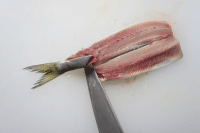 |
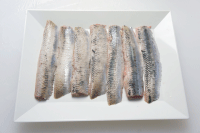 |
| 6, separate the tail from the body that was open | 12, sashimi and sushi of sardine is fully equipped ready |
This method is a problem of poor yield rate can suffer but sardine is the biggest drawback "small ventral bones are often, eating less" regard is the process of "deliciousness priority" which overcomes almost completely.
First, without skin three fillets using (1 fish half), we made the "Kanoko tukuri of sardine sashimi".
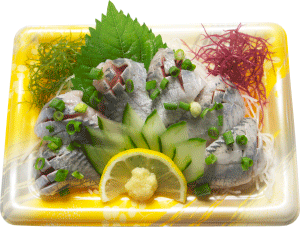
Put shallow decorative knife Kanoko pattern in skinless fillets, cut in the transverse direction half. And lightly bending, to put it to the dish. And topped with chopped green onion from the top, and add the grated ginger.
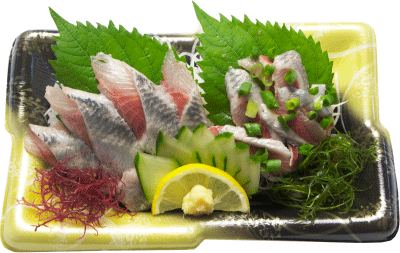
Next, create a two mountain in radish Ken, usutukuri sashimi to the left of the mountain, to the right was dishing the itotukuri sashimi. Since only material in an amount of between 1 fish sardine in two skinless filet that was used to this, cost is suppressed lower than Kanokosashimi of the above image.
The next is a nigiri sushi.

Decorative knife not only Kanoko pattern, vertically to make or three those long notch was the amount of 1kan was cut in half laterally, respectively. Then arranged 6kan by 3kan them alternately, by topping the ginger and chopped green onion grated on top of the sushi items, it was to reduce the fishy smell of sardine even a little.
Since skinless fillets with three, but the amount of raw material is the same as Kanoko sashimi of the above image, and if the same selling price, and the customer is the person to choose the direction of perhaps nigirisushi in terms of sense of volume is large Seem.
And was dishing to one of the dish sashimi and sushi, which has been described above, is it is also the prefacing image "all of the sardine".
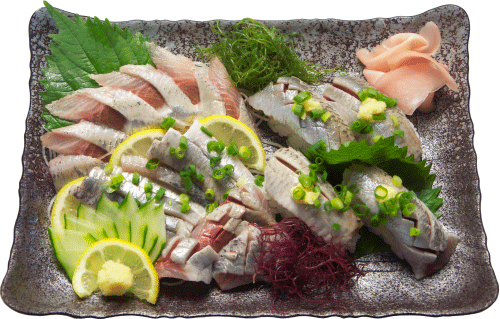
This is not even just sashimi of sardine, not just nigiri sushi. I think whether not not seen much in the shop is because products that both were together in one.
Sardine that was used this time, freshness is well, yet because it was Honor Roll of subcutaneous fat plenty, people of the opinion that tasted it was very well received. There is a feel of the respond and eat only thickness than the current time of saury, appeared to be a taste to go on definitely than lean saury.
Well next, trying to introduce the delicious cuisine method of sardine to the national not well known.
The cuisine of Japan of sardines, grilled, fried tempura, boiled fish, namero (miso bashing), stew, oil sardines, there are various things such as.
For example, it, Chiba Prefecture, and "namero sardines" in the sotobo "sardine of sanga-yaki", and there is a famous dishes such as "shioiri sardines" of Kanazawa around local dishes, other to around Kitakyushu, Fukuoka Prefecture is there is that "Nukamiso of sardine cook".
According to one estimate, Tadazane Ogasawara in 1617 became transferred to Harima koku Akashi (current Akashi, Hyogo Prefecture) 100 000 stone, even in 1632 Buzen koku Kokura (the currentIt became a change in Kitakyushu, Fukuoka Prefecture) 150 000 stone. And one of the servants who have followed the Ogasawara monarch, was introduced in Kokura Domain this dish that seems to be stemming from the Kansai Hokuriku is the beginning.
One of its theory, was the preserved food except for the smell of perishable blue fish is also a theory that an idea cuisine of Kokura Castle palace maid. Alias of sardine Nukamiso cook of this Kokura lore are also referred to as "Jinda boiled", and Jinda it is that of the rice bran.
Once upon a time, there is a rice bran miso in most of the house of Japan, there is the original flavor for each house, it seems there was also home to know and love the subsequent ancestral rice bran miso more than 100 years in it. This is because the fermentation bacteria is alive, once a day to stir the entire by hand, it is necessary to expose firmly in the air, because those consuming very troublesome, recently has become home to make rice bran miso also less.
Sardine in such historical background, even now there are a number of rice bran miso shop and fresh fish shop from Kokura Castle in such Tanga market, which is within walking distance in Kitakyushu, which was a unique seasoning in each store at the corner rice bran miso cook has been sold.
Contents to be introduced below, rather than such business to become such a authentic thing, it is cooked sardine Nukamiso a simplified version that Nukamiso also made using a commercially available rice bran miso.
| How to make of Sardine Nukamiso cook (a simplified version) | |
|---|---|
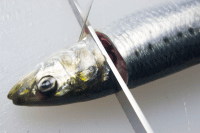 |
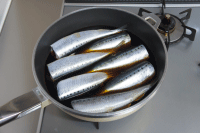 |
| 1, Dropping the head while with a chest fin | 5, if you cooked once, and placed side-by-side sardine |
 |
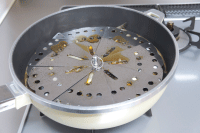 |
| 2, The belly is not cut open, to take out the internal organs in the state of tutunuki | 6, Place a lid that can be placed deep inside the pot, cook 10 minutes over low heat |
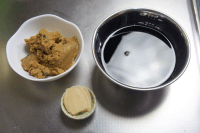 |
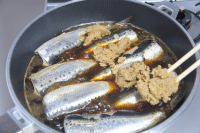 |
3, 1 cup of water / cooking wine 1 cup / soy sauce 1/2 cup / mirin 2 tablespoons / sugar 6 tablespoons / Nukamiso 200g / ginger little (amount of sardine 7 fish) |
7, When the sardine is cooked, put Nukamiso |
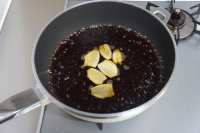 |
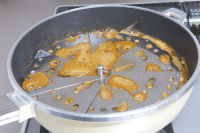 |
| 4, put the sliced ginger in a pot, and simmer 1 times | 8, about 10 minutes over low heat, and finished Once you've cooked up to get thickened of Nukamiso |
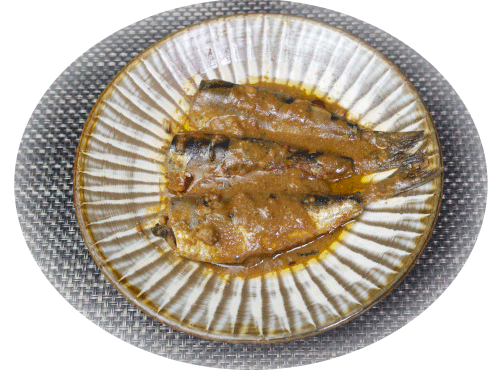 |
|
The above steps but is a simplified version of sardine Nukamiso cook make at home, if you try to create delicious over the more earnest time, (1)to stop the fire After boiling boiled. (2) 8 hours much kept warm as it is. (3) Thereafter sardine only put in heat-resistant container. (4) The boil remaining cooking liquid to until one third of in small pots. (5) Nukamiso were placed, and to a suitable hardness. (6) poured into the cooking liquid on top of the sardine of the heat-resistant container. (7) After that you cook with rice further in a pot, and finished.
Delicious cuisine of sardine is present in various forms across the country, but Nukamiso of sardine cook is only one of them, so this dish is not necessarily cuisine became known well to all over the country, this magazine in it is was decided to introduce.
When Nukamiso cook cuisine simmer slowly and carefully over a period of time in the authentic way, is a little cooking of waste that can be eaten is soft to the bone of the sardine, it is also a save food can be saved for more than a week as it is at room temperature. Moreover sardine as you know, contain such a wealth of DHA and EPA, because it is a great Honor Roll in nutrition, it is the wonderful cuisine in various surface.
Although took up the sardine by multiplying the fact that "sardines Day" of this month's issue is October 4, it was re-recognized again "taste of the big sardine that fat is a lot." To the so tasty fish in fertilizer and feed, it is really wasteful.
While not forgive prejudge whether now or ahead, continue to increase the catch of sardine, for example for saury, when viewed from the many years of the movements up to now, there is a greater anxiety in the future. However, for sardine and mackerel, there are things you feel is visible a little bright situation to catch this ahead.
Kawasaki Ken's Tohoku University professor emeritus announced the concept of "regime shift (conversion of the basic structure)" in 1985.
This is "because that changes in climate and marine environment decades unit, the number of fish also varies periodically" is a hypothesis that.
By then various studies, weakening of activity of low pressure that occurs in the winter near the Aleutian Islands, have been found to be the identity of the environmental factors of sardines of increase or decrease.
When the low-pressure activity is weakened, rising temperature of the sea water, and food for plankton decrease development of sardine fry becomes poor, the bonito and tuna that inhabit the warm waters up north, fry becomes their prey It has since become.
Like mass media of that inflame, but this than disappear from the earth was expressed as either not "illusion of fish sardines" is, there is also a theory that repeat a large increase or decrease in the approximately 100-year cycle, rather than far from several decades Unit . It is where some very interesting what will happened multi-catch of fish species sardine that was also known as the grass of the sea in the future.
At least, I can say at the moment is that should not despise fish that so delicious sardine as a lowly subordinate fish.
If you capture the timing of this year's saury of poor catch, it might be a good opportunity to review the sardine.
An opinion and the communication are to iinfo@fish food times
Date of updating Oct.1, 2015
